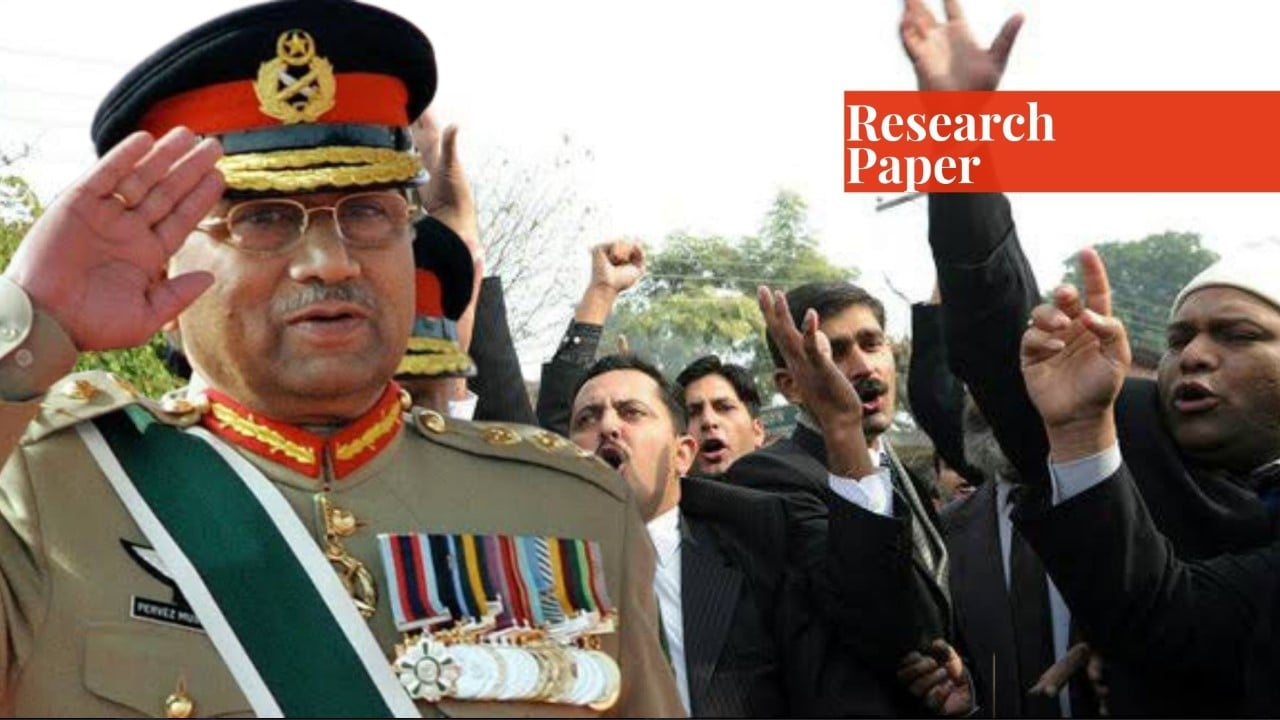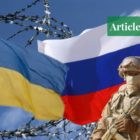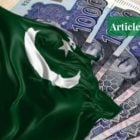Amna Shaukat is currently studying social sciences at National Defence University, Islamabad.
Judiciary vs Musharraf
Iftikhar Chaudhry was appointed Chief Justice of Pakistan’s Supreme Court in 2005. He led the court in ways that were politically inconvenient for then-President General Pervez Musharraf, such as questioning Musharraf’s dual role as president and Army chief. On March 9, 2007, President Pervez Musharraf removed Chaudhry as Chief Justice, claiming that he had abused his position, prompting the Lawyers’ Movement in Pakistan.
The Pakistani legal society widely interpreted Musharraf’s action as an attempt to limit the Supreme Court’s rising independence under Chaudhry’s leadership, and the Pakistani legal community quickly organised widespread non-violent protests against Musharraf’s action. The attorneys created a movement known as Adliya Bachao Tehreek.
Approximately 80,000 attorneys united to restore Chaudhry’s position as Chief Justice and gain judicial independence in Pakistan. A Pakistani Supreme Court advocate simply described the movement’s emergence as the first time in Pakistan’s history that lawyers shed their opposing political loyalties and forged an unparalleled professional unity to restore the rule of law.
Following Chaudhry’s suspension, lawyers around the country staged non-violent marches and protests. The authorities reacted violently to the lawyers’ non-violent tactics. As per Human Rights Watch, “authorities aggressively crushed the resistance by beating lawyers, opposition activists, and media workers covering unfolding events.”
Despite the harsh persecution, the lawyers remained peaceful, and on July 20, 2007, Musharraf yielded to the strain of the lawyers’ movement by reinstalling Chief Justice Chaudhry. The reinstatement of Chaudhry was a stunning achievement for the four-month-old movement, but it was temporary. Just a few months later, Musharraf returned to oppressing the judiciary.
Once More
On November 3, 2007, Musharraf declared and issued a state of emergency in Pakistan. The lawyer’s movement rapidly organised to oppose Musharraf’s declaration of emergency in Pakistan. In a daring and unusual act of disobedience, around two-thirds of Pakistan’s 97 senior judges refused to acknowledge the implementation of emergency rule, and a quick crackdown started.
All of the judges who refused were sacked, including Chaudhry. Despite the arrests, lawyers across the country stood together in defiance of Musharraf’s suspension of the constitution. Musharraf resigned as military chief on November 28, 2007, and declared emergency rule on December 15, 2007, in response to civil pushback from lawyers and mounting international pressure.
In the wake of the 2008 elections in Pakistan, the lawyers’ movement grew in power through a series of coordinated peaceful acts. Musharraf resigned as president on August 18, 2008, fearing prosecution by the newly elected parliament. The fight for a free judiciary, however, did not end with Musharraf’s resignation. Despite electoral promises, the subsequent election of Benazir Bhutto’s widower, Asif Ali Zardari, as president on September 6 resulted in minimal freedom for the judiciary.
As a response, the lawyers’ movement organised a major march in Islamabad, which was backed by many civil society allies in Pakistan, and Zardari was obliged to reinstate Chaudhry as chief justice on March 16, 2009. Over the course of around two years, the lawyers’ movement achieved its organisational aims primarily via the employment of nonviolent techniques.
Research
The ‘men in black’, who focused on the rule of law and supported nonviolent struggle, captivated the hearts and minds of millions of Pakistanis and aided in the unanticipated transformation of the country’s political landscape. However, the success of this movement does not rest on a single factor. The research question posed in this paper is to analyse the underlying variables that led to the success of the lawyers’ movement in Pakistan.
To achieve this research’s major objectives, I have used social movement theory as an interpretive approach that focuses on the anatomy and structure of the lawyers’ movement in order to analyse the key features that led to the movement’s success. The research is deductive in nature as it examines the data which is qualitative and narrative in nature.
Social Movement Theory and Lawyers’ Movement
According to Mancur Olson’s theory of social movement, individual rationality is at the heart of all social movements. His intellectual principles also served as the framework for resource mobilisation theory (RMT). The RMT technique is often described in the context of a larger resource mobilisation concept.
The movement’s major focus is on how it uses human, economic, cultural, and political resources. The RMT addresses individuals rational consideration of various costs and rewards associated with movement involvement. For RM theorists, ordinary decisions, particularly those made by leaders of social movements, serve as a starting point. (Nepstad, 2013)
There is a growing preference for non-violent social movements over violent ones as seen in the writings of well-known former leaders of nonviolent movements, such as Mahatma Gandhi and Martin Luther King Jr., who made significant contributions to the non-violent discourse. The Pakistani lawyers’ movement was a self-sufficient and indigenous nonviolent movement seeking political reform.
According to the main theory of nonviolent action, large numbers of Pakistanis wielding nonviolent weapons such as mass protests, long marches, sit-ins, and workers-led resistance undermined the legitimacy and power of the Musharraf and Zardari governments, especially after non-violent resistance was met with government repression (Ahmed & Stephan, 2010, p. 20).
Leadership and Decentralised Organization
Leadership is vital to the success of any non-violent social movement. This position was best performed by leaders such as attorney Aitzaz Ahsan, Munir A. Malik, and Ali Ahmed Kurd in the lawyers’ movement. Aitzaz Ahsan, Pakistan’s foremost constitutional lawyer, played a pivotal role in successfully spearheading the movement. Despite considerable divisions on other matters, the movement’s leadership stood unified throughout the revolution.
Although affiliated with different political parties—Aitzaz Ahsan with the PPP, for example—they maintained considerable independence from outside pressure. This not only increased their credibility in the eyes of their followers but also ensured that the campaign continued without interruption. Their constant mass contact and inspiring speeches drew attention to the issue and made it meaningful.
The movement was organised by a small group of attorneys led by Aitzaz Ahsan, who led the 160 local bar councils and associations in Pakistan, which had 85,000–90,000 members. The National Action Committee of Lawyers (NACL) was the movement’s main decision-making body, and its main leaders Ahsan, Ali Ahmad Kurd, Munir A. Malik, Hamid Khan were consulted on the majority of decisions (Fatima & Tariq, 2021).
The movement’s nationwide infrastructure and decentralised nature (but with centralised leadership) strengthened the movement’s organisation and communication, increased unity of effort, and made it extremely difficult for the regime to repress its actions. Moreover, the NACL profited from the dynamic leadership.
However, charismatic leadership cannot compensate for a lack of organisation, which is where non-violent resistance’s power lies. Although they were not officially integrated into the lawyers’ movement’s decision-making structure, Pakistani NGOs and civic groups offered important logistical and informational support to the campaign and facilitated resource mobilisation, particularly during the March 2009 long march.
The majority of the material resources required to power the movement came from within Pakistan, initially from the lawyers’ own pockets. The Lahore High Court Bar Association started the initiative with only Rs. 1000 and subsequently ran a campaign to raise more money. Most bar associations were self-sufficient in terms of collecting and disbursing funds. Later, the lawyers’ main political supporters, the PMLN and the PTI provided funding and organisational support.
Effective Communication
The success or failure of a social movement is primarily determined by the media’s substance and symbolic representations. The involvement of the media in assisting the movement’s goals was beneficial. The effective use of the media and alternate channels of communication bolstered the movement’s durability and leverage even further.
Once again, the decentralised, well-organized network of bar councils at the province and district levels facilitated intra-movement communication and coordination. The majority of movement instructions came from the NACL and were delivered to the heads of the local bar councils through cell phones. The local officials, in turn, communicated with the members of the local bar.
An NACL coordinator was assigned to each provincial bar association to deliver messages to all district and city bar councils in that province. Information on opposition activities was mostly disseminated to the Pakistani public via television, most notably through popular chat shows on Geo, Aaj, and ARY TV channels.
The regime did try to control the flow of information; Pakistan Electronic Media Regulatory Authority (PEMRA) enforced severe limits on live shows in June 2007, forcing those TV channels to dismiss their well-known anchors. Zardari used similar methods before the 2009 long march, where he banned the transmission of Geo TV.
In response to the blackouts, masses of lawyers, politicians, human rights activists, and civic groups gathered outside the Geo TV office in Islamabad and watched as Hamid Mir, the Geo TV anchor, continued to broadcast a popular programme, Capital Talk, even though it was never transmitted (Abbas, 2021). International broadcasters, particularly the BBC’s Urdu and Pashto services, provided up-to-date news and commentary on their radio shows and websites.
Protests were announced in numerous English and Urdu newspapers. The Pakistani blogosphere exploded at a time when other communication channels were shut down. Tributes to the movement were made on existing blogs, and new web-based efforts, such as the Pakistan Justice Coalition and the Movement for the Rule of Law, were established to report on movement activities and disseminate information on protests and rallies.
Non-violent discipline is an important element of non-violent struggles that succeed. Movements that make their commitment to peaceful tactics are more likely to garner broad-based (domestic and international) support than violent efforts. They also have a higher chance of making the opponent’s use of violence backfire. In the face of state brutality and repression, the lawyers’ movement in Pakistan demonstrated amazing nonviolent discipline.
Non-violent Discipline
The movement’s few acts of violence were fiercely denounced by the movement’s leadership, who did not believe that the rule of law could be restored in Pakistan by violent methods. Nonetheless, there were incidents of intra-movement violence and violent attacks on regime employees that jeopardised the movement’s unity and integrity.
During rallies, for example, stones were thrown at the Pakistani police. Despite this, the movement’s leaders, particularly Aitzaz Ahsan, insisted on non-violent discipline throughout the struggle. He was even hesitant to condone more aggressive and provocative activities by the lawyers and their followers, which could have quickly escalated into violence.
During big marches and demonstrations, for example, slogans and chants were utilised to encourage unity. These ranged from the simple and straightforward (‘Justice for Chief Justice,’ ‘Go Musharraf Go’), to comparisons between Musharraf and Zardari (‘Musharraf Zardari bhai bhai, Pakistan ki shamat’).
One of the most popular phrases, ‘Hum mulq bachaanay chalay hain, aao hamary saath chalo’ (Come with us, we will protect the country), was sent to thousands of Pakistanis by text message. The redirection of youth energy and activity into non-violent means of resistance aided the movement in maintaining peaceful discipline and expanding public involvement.
External Support
The lawyers’ movement also received backing from lawyers and human rights organisations all around the world. Many bar groups and prominent lawyers urged the reinstatement of the ousted Chief Justice, putting extra pressure on the military administration.
Simultaneously, Justice Chaudhry became the third person in history to be awarded the coveted ‘Medal of Freedom’ at Harvard Law School, in honour of his individual efforts to safeguard the legal system’s core dedication to freedom, justice, and equality (Hussain, 2016). The lawyers got considerable financial assistance from the Pakistani diaspora in Europe and North America.
The PTI established the ‘Long March 2009 Fund’ to allow Pakistanis living abroad to donate to the fight for an independent judiciary. Lawyers and bar associations from the United States, Canada, and the United Kingdom, as well as the Commonwealth Lawyers Association, the South Asia Bar Association, the National Lawyers Guild, Amnesty International, and Human Rights First, provided material and political support to Pakistani lawyers.
International organisations such as the International Commission of Jurists (Geneva) and the International Federation for Human Rights (Paris) paid visits to Pakistan to assist the lawyers’ cause. These international efforts enabled the lawyers’ movement to broaden the non-violent battlefield while also increasing its worldwide awareness and influence.
Conclusion
‘The success of this two-year-long combative and continuous movement in the face of obstructive governmental apparatus and several other barriers has transformed the country’s political dynamics,’ notes famous Pakistani researcher Hassan Abbas. This paper’s research demonstrates that the lawyers’ movement in Pakistan can be explained using social movement theory. The explanation provided by the social movement theory adds to our understanding of the movement.
Non-violent social movements are not limited to Western nations; they may be formed in developing countries like Pakistan, where the military ruled politics for more than three decades and where the court mostly served as a rubber stamp in the hands of strong administrators. The peaceful campaign led by the ‘men in black’ and supported by a large number of ordinary Pakistanis set the stage for the effective downfall of the dictatorship.
References
- Abbas, M. S. (2021, March 5). Lawyers’ movement for the renaissance of the independent judiciary in Pakistan. SSRN. https://doi.org/10.2139/ssrn.3760263
- Ahmed, Z. S., & Stephan, M. J. (2010). Fighting for the rule of law: civil resistance and the lawyrs’ movement in Pakistan. Democratization, 17(3), 492-513. https://doi.org/10.1080/13510341003700360
- Fatima, N., & Tariq, S. (2021). Critical analysis of social movement theories during lawyers movement 2007 to 2009. Journal of Business and Social Review in Emerging Economies, 7(2). https://doi.org/10.26710/jbsee.v7i2.1720
- Hussain, S. (2016, September 25). Rule of law, justice and constitutionalism: Political mobilization in the ‘lawyers’ movement for the restoration of judiciary and democracy’ in Pakistan. SSRN. https://doi.org/10.2139/ssrn.2843284
- Nepstad, S. E. (2013). Nonviolent civil resistance and social movements. Sociology Compass, 7(7), 590-598. https://doi.org/10.1111/soc4.12051
If you want to submit your articles, research papers, and book reviews, please check the Submissions page.
The views and opinions expressed in this article/paper are the author’s own and do not necessarily reflect the editorial position of Paradigm Shift.



















